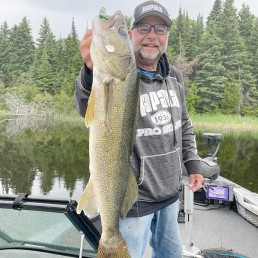All About Casting Jigs
SHARE THIS POST
When people talk about jigging for walleyes, they immediately imagine a vertical presentation in a river, often in deep water, and usually in early spring. While that’s a standard jigging practice, that’s not the half of it. Jigs are versatile baits that produce under a variety of circumstances, and anyone who limits their jigging to vertical presentations is missing out on a lot of opportunities. Casting jigs, for example, is not only productive, but fun.
Casting jigs produces whenever the water isn’t hard (ice). It begins right away at ice-out. Warm water is not only more comfortable for the fish at this time of year; it’s more comfortable for baitfish, too.
There is no such thing as too shallow. I will fish 6 inches of water when the open-water season begins, and that’s something I think a lot of anglers miss; they want to fish deep, because that’s where they’ve caught them before. But often the shallowest water is the warmest—especially on sunny days—and you can always move deeper if you’re not finding fish. Start shallow.
If they’re not there, move out—but don’t go too deep. In summer, you can catch walleyes in 85-degree water if the food is there; if it is, the predators are going to be there, too. (And as a side note, there are many other species of fish in there, too; you’ll catch perch, bass, pike—a litany of fish. And it may go on for the whole season.
If I found fish, I stayed on them. Rather than leave an area, I’d make another pass and switch things up. I’d start out by changing the color of the plastic trailer—or the style of the trailer: paddle tail, curly tail, straight tail, etc. that I’m hanging on the jig. Keep changing. You may try a color that you’ve never used in your life, and it will become your favorite color by the end of the day.
Or I might change the color of the jig head I’m using. If you fish an area thoroughly, the fish have already seen what you’ve been showing them plenty of times. Show them something different; something different will attract new customers.
On that note, you can always add a spinner to your jig—either a conventional safety-pin style overhead spinner, or an underspin such as a Roadrunner jig. The spinner adds both flash and vibration to your presentation and that’ll attract the predators. Overhead spinners have another benefit: They make jigs more snag resistant. As the weeds begin growing, that’s where things are happening. The small critters that hang around weeds attract the minnows that’ll be in there feeding on them. If the food’s there, the walleyes are going to be there.
Are you enjoying this post?
You can be among the first to get the latest info on where to go, what to use and how to use it!
Wear polarized sunglasses. When you’re reeling your bait in, you’ll often see fish trailing it. They’ll come right up to the boat and then veer off. If you’re fishing with your buddy, immediately tell him/her to keep a sharp eye out for followers. (They should use a slightly different bait so you’re not showing fish the exact same thing.) He/she can flip a bait in front of that following fish before you finish reeling in your bait. And it doesn’t hurt to figure-eight your jig just like the muskie fishermen do. It works for walleyes, too.
As summer progresses and the fish move out to drop-offs or weed lines, begin fishing weed beds in deeper water. Start by snap jigging if the weeds aren’t too snag. After you cast and the bait hits bottom, just jump it forward, then let it fall. Move slowly—if necessary, switch to a bigger jig to ensure bottom contact between forward sweeps of the rod tip. The deeper the water, the more important jig size becomes. A bigger jig gets more attention; it hits the bottom harder, stirring up bottom sediment and making more noise.
As for the best line, I often start with fluorocarbon, such as Suffix Advance. I like 6-pound test for casting jigs. It’s light enough to cast far and it cuts the wind better than heaver line, so you get less bow in your line. I like green line because I can see it better. If there’s heavy weed cover, I switch to a superline like Sufix 832 Advance. Braided lines cut through the weeds better than other lines, and you don’t want to hang up and pull the weeds out; it turns the fish off just like you were flipping off a light switch. If you snap your jig off the weeds, you’ll draw the attention of the fish instead of chasing them off. Often, fish grab the jig immediately when you snap it off the weeds.
Numerous jighead shapes work under different conditions. But when it comes to casting jigs, I prefer an old-fashioned round head jig like the basic Northland jig. I find that it works best.
One thing I haven’t mentioned yet is casting (or vertically fishing) jigs with live bait for trailers. But that’s a whole other story.
For more insight and tips for fishing throughout the year, check out the articles in every issue of MidWest Outdoors, available by subscribing on our website.
MWO
SHARE THIS POST
You may also like...
Nothing found.
Did you enjoy this post?
You can be among the first to get the latest info on where to go, what to use and how to use it!
Mark Martin
Mark Martin is a professional walleye tournament angler and instructor with the Ice Fishing School/Vacation series. For more information, check out his website at markmartins.net or fishingvacationschool.com.
